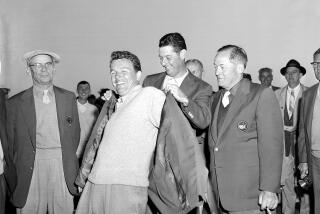This Writer Qualifies as a ‘Goof’ for Golf
- Share via
In the golfing world, a “goof” is someone who drives 400 miles just to see a particular foursome, who arrives on the green at 6 a.m. to follow Jack Nicklaus, who drops everything for a chance to play 18 holes.
William Hallberg is a goof.
“I can be in the middle of writing a story, and it could be going beautifully,” explained Hallberg, 38, an English professor at East Carolina University and author of the novel, “Rub of the Green.”
“If some friend of mine called me up and said ‘Bill, let’s go down and play this course, I would say, ‘Let me finish this paragraph,’ that would be my rationalization, and off I would go.”
He has collected more than 500 golf novels and short stories, dating back to the mid-19th century, and raids bookstores around the world looking for more.
On the walls of his home in Greenville, N.C., hang a dozen or so golf paintings as well as framed maps of courses. Hallberg is also the proud owner of several “hideous” golf ashtrays, one of them lined with ceramic golf balls, and has a closet crammed with gear, including a left-handed mashie made in 1887.
In front of his house stands a hallowed out stump that serves as target practice for Hallberg’s pitching wedge. His “lawn,” or what’s left of it, is riddled with divots. A shanked pitching wedge resulted in a broken window. Golf balls roll around on the floor of his car.
He has traveled from England to Israel in search of the holiest of grails: the perfect golf course. Hallberg was so overwhelmed by a course in Scotland, he nearly dropped to his knees and wept. By his own count, Hallberg has played on more than a thousand courses and is seeking new ones all the time.
How did it ever get this far?
“I think it may be the last bastion of civility in sport,” Hallberg said. “It’s also a sport that requires a different playing field every time. It’s also a mass participation sport. Folks in their 90s play it. Everyone has some aesthetic connection to the sport.”
Hallberg, the son of a zoology professor, had a golf course across the street when he grew up in Bowling Green, Ohio. He started playing at age 9, at first gripping the club like a baseball bat. His game soon improved -- he now lists his handicap at about seven -- and his passion began.
“I liked the greenness of the sport. I liked the difficulty of the sport. It was a sport where you could never achieve perfection. There’s infinite room for improvement.”
As a teen-ager he read F. Scott Fitzgerald’s short story, “Winter Dreams,” and became interested in golf literature.
“Golf yields up beautiful short stories,” said Hallberg, who compiled “Perfect Lies,” a collection of golf stories that includes works by Ring Lardner, John Updike and Walker Percy.
“There are countless numbers of baseball novels, probably 20 or 30 that are very good, but very few good short stories. It’s the exact opposite with golf. I’ve got hundreds of golf novels, but they’re usually mysteries or kind of corny, foolish parodies of the game. Never has there really been a novel that seriously explored the metaphorical possibilities of the game.”
Not wishing to let baseball have all the glory, Hallberg began writing “Rub of the Green,” published last year. Hallberg worked on the book for a year and a half, at times finding sentence construction as frustrating as the 18th hole at Pebble Beach.
“Lots of times I wanted to tear it up and throw it away. I’m the same kind of writer as I am a golfer, I just go back. You hit one good shot and you want to go back and play it again. You get one good line you go back to the typewriter and say to yourself, ‘I can have that kind of day again.”’
He limits himself to once a week on the course during the school year, but indulges once classes let out, often playing every other day. Hallberg will head for Scotland this summer, hoping to discover four or five great unknown courses.
“When I fly on an airplane and look out the window, I’m looking for golf courses. That’s what I do. ‘There’s a golf course right there, it looks like a nice layout.’ ‘There’s a bad one.”’
But what makes a great course?
“A golf course that really appeals to me is one that’s honed right out of the terrain, that doesn’t bring in a lot of dirt,” said Hallberg, a reviewer for Golf Digest.
“The trees that were there are still there. The dunes and mountainsides that pre-existed the golf course are complete. The best golf courses compliment what nature’s already provided.”
More to Read
Go beyond the scoreboard
Get the latest on L.A.'s teams in the daily Sports Report newsletter.
You may occasionally receive promotional content from the Los Angeles Times.










